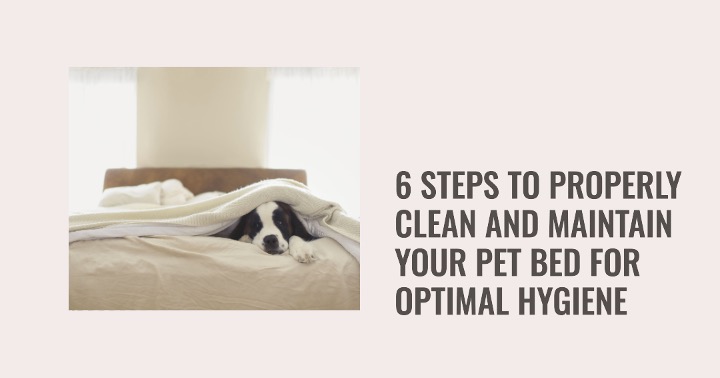As a pet owner, you want to ensure your furry friends live comfortably by staying clean all day. Yet, the hygiene of their bed is one issue most people often disregard. Allergens, bugs, and disagreeable odors may be present in a soiled pet bed, leading to illnesses.
Thus, it's essential to maintain and clean your pet's bed to provide the highest level of hygiene. We'll walk you through six easy steps in this article on properly cleaning and preserving your pet's bed. By taking these actions, you may give your pet a tidy and warm area to sleep while lowering the likelihood of health problems.
1. Remove Loose Debris
Removing loose debris is the first step to cleaning and maintaining your pet bed. These include pet hair, mud, leaves, and other debris that may have gathered on the surface. You can use a stiff brush, a lint roller, or a Hoover cleaner with a brush attachment to remove this debris effectively.
Thoroughly clean the bed's surfaces to eliminate as much loose debris as possible. It's best to get a soft and squishy texture bed to make this easier. For instance, the plush and soft fabrics of a squishmallow pet bed offer greater flexibility. Thus, it's simpler to lift or brush away specks of dirt from each corner.
Further, since dirt accumulates more in seams, fissures, and corners, please pay more attention to them.
2. Pre-Heat Stains
It's important to pre-treat any stains on your pet bed before washing. You may need to treat different stains using various techniques. However, one common type of stain on pet beds is urine stains.
Urine contains uric acid crystals that can leave stubborn stains and unpleasant odors behind. So, use a specializedenzymatic cleaner for pet stains to remove urine stains successfully. The enzymes in these cleaners help break down the organic molecules in urine, which removes the stain and odor.
To pre-heat a urine stain, blot up as much urine as possible with a paper towel or clean cloth. After that, saturate the discoloration with the enzymatic cleanser, ensuring it gets into the bed's fibers. Adhere to the manufacturer's directions about the quantity to apply and the period it should be on the stain. This way, the enzymes can break down the uric acid crystals.
Then, blot off any extra moisture with a fresh cloth or piece of paper after letting the cleanser sit for the suggested time. If required, repeat this procedure until the stain and smell are gone.
3. Check the Washing Instructions
Before washing, you must review the manufacturer's recommended washing instructions. Depending on the materials and construction used in each pet bed, each one may have different cleaning requirements. So, to clean the bed without causing damage, read the labels or any accompanying instructions.
For instance, you may find a label that reads "machine washable" on some pet beds, proving that you can wash them safely in a washing machine. Removing any removable covers or cushion inserts is advised for more thorough cleaning in such situations before washing. Also, the labels may offer instructions on the proper water temperature settings to preserve the bed's fabric.
However, certain pet beds might not suit machine washing because of their delicate compositions. Here, spot cleaning or hand washing may be better. Spot cleaning is applying a cleaning solution to stains or dirty spots to wash the affected area. On the other hand, hand washing entails soaking the bed in warm water with a moderate pet-friendly detergent, then scrubbing and rinsing.
4. Avoid Harsh Detergents
Avoid using harsh detergents to keep your pet's bed in good condition and ensure their safety and comfort. Harsh detergents may contain strong chemicals and additives. And they can be too abrasive or unpleasant for the delicate textiles and materials used in pet beds.
These powerful detergents can deplete the fabric of the bed's natural oils. This could cause excessive wear and tear, fading, and even the gradual breakdown of the fibers. Also, residue left behind by abrasive detergents may hurt your pet's skin, causing allergies, inflammation, or itching.
Instead, choose gentle detergents or detergents that are specially made for cleaning pet-related objects. These items remove dirt, stains, and odors without harming the components that make up the bed. They are devoid of abrasive ingredients, perfumes, and colors that could irritate your pet's skin.
Always refer to the pet bed's manufacturer's stated washing instructions when in doubt. They could provide detailed advice on the detergent to use. This ensures you pick a solution to clean the bed while keeping your furry buddy safe.
5. Dry Thoroughly
To avoid mold and mildew formation, it's essential to completely dry the pet bed after washing. After washing, ensure the bed is completely dry before giving it to your pet again. The most efficient way is often air drying since it effectively removes moisture.
Find a well-ventilated place, ideally outside, and hang the bed flat. Avoid direct sunlight as too much heat might fade and harm the fabric. The airflow will encourage evaporation and guarantee that the bed dries well.
Afterward, choose a low heat or air-dry setting on the dryer to prevent shrinkage or other harm to the fabric. Observe the bed as it dries and remove it from the dryer as soon as it seems dry. When the bed is completely dry, fluff it up to give it back its shape and provide your pet with a soft surface to lounge on.
This step is necessary for maintaining ideal hygiene and extending the life of your pet's bed.
6. Clean Your Pet's Bed Often
Aim to give your pet's bed a good wash with pet-safe detergent at least once a week to keep it fresh. Vacuum the infill in the pillow or cushions regularly - this can help prevent fleas and other pests from residing in your pet's bed! Also, you can spray pet bed cleaners over their beds while washing to keep things smelling fresh.
Your home is important when you have pets, so it pays to prioritize hygienic cleaning routines. Don't let dirt or germs build up, as this could cause health issues for you and your fur friend.
Bottom Line
Keeping your pet's bed as clean as possible is essential for their comfort and health. You may effectively clean and preserve your pet's bed by following the six procedures described in this article. They include removing loose debris, pre-treating stains, reviewing washing instructions, and more. Following them ensures your cherished pet has a clean and cozy sleeping space.






































